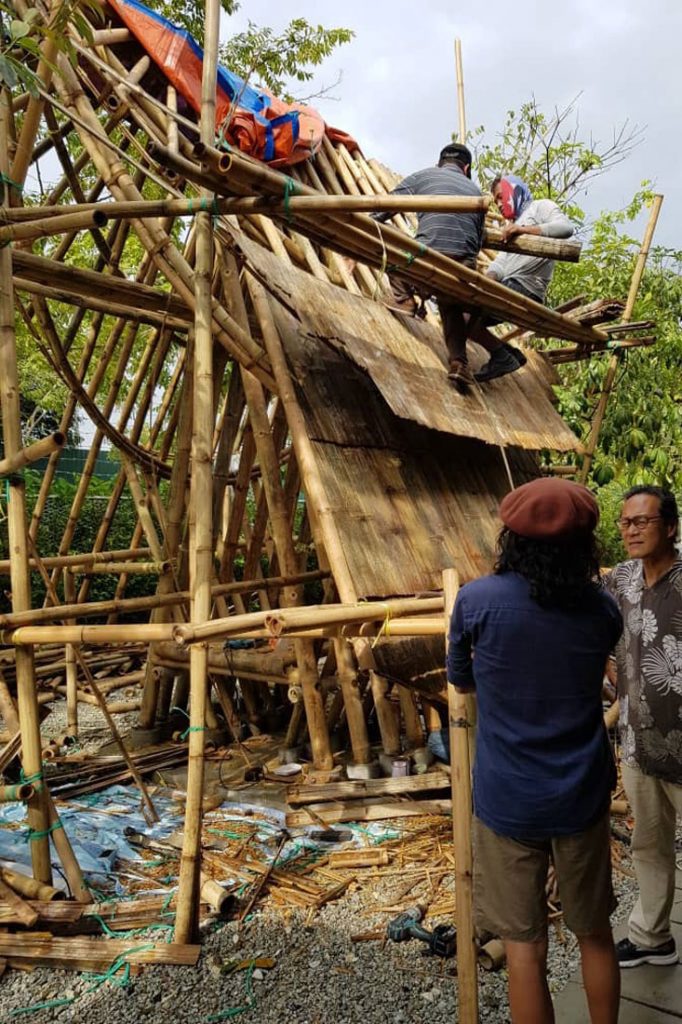Two talks held during the Kuala Lumpur Architecture Festival 2019 by architects Eleena Jamil and Low Ewe Jin discussed the viability of bamboo as an architectural material in urban and suburban contexts.

July 5th, 2019
While a hardwood tree takes decades to cultivate, bamboo shoots one metre a day, maturing within five years requiring little maintenance. They absorb large amounts of carbon dioxide and release more oxygen than the average tree.
Dubbed as ‘green steel of the 21st century’ by Vietnamese architect Vo Trong Nghia, bamboo outperforms steel in tensile strength but is lightweight, flexible and does not require heavy machinery to handle.
Such qualities have made the wild grass ideal for building resorts in exotic destinations or disaster-prone areas.
This was a topic of interest at the Kuala Lumpur Architectural Festival 2019 themed ‘Tomorrow’. Sharing their knowledge and experiences, architects Eleena Jamil and Low Ewe Jin believe that there is still untapped potential when it comes to bamboo architecture.

Eleena Jamil
As a relatively young industry, a lot of research, 3D-modelling and testing need to be undertaken for successful results. This was the case for Jamil’s work on the Bamboo Playhouse, the first formal bamboo structure in Malaysia, completed in 2015.
Jamil relied on meticulous sampling and loading tests to ensure structural safety as no engineer was willing to vouch for the project; the help of the native people who went into the forest to scour for the ideal bamboo, as well as craftsmen from Indonesia. The public pavilion, originally submitted as a temporary installation, continues to be a space for people to meet, play and rest today.
Despite the obvious benefits and abundant supply, bamboo is not aspirational, partly due to its association to impoverished circumstances and ability to attract insects, if poorly treated and designed.

Challenging that perspective, Jamil’s eponymous studio has been working on bamboo terrace houses that are appealing and affordable to urban and suburban dwellers, perceiving bamboo as an “everyday construction material”, like steel, concrete or bricks.

Low Ewe Jin, previously a lead architect at Bali-based bamboo architectural firm Ibuku, shared valuable know-how of working with the material, explaining the various species, treatments and how bamboo can be drilled, tied, weaved, bundled, bent or fanned out.

Low Ewe Jin
He believes that bamboo architecture can go as tall as ten storeys and last a lifetime if harvested, treated, designed and built well. Raising bamboo structures off the ground and opting for overhanging roofs to protect the material from the elements are examples of best practices.

When asked about the lack of bamboo in urban spaces, Low explains: “The main issue with bamboo now is compliance. There is nothing [about bamboo] in the building code,” he says.

A searchable and comprehensive guide for specifying leading products and their suppliers
Keep up to date with the latest and greatest from our industry BFF's!

Elevate any space with statement lighting to illuminate and inspire.

Following its successful inaugural event in early 2024, the Vietnam International Trade Fair for Apparel, Textiles, and Textile Technologies (VIATT) is gearing up for its next instalment in 2025.

XTRA celebrates the distinctive and unexpected work of Magis in their Singapore showroom.

In this candid interview, the culinary mastermind behind Singapore’s Nouri and Appetite talks about food as an act of human connection that transcends borders and accolades, the crucial role of technology in preserving its unifying power, and finding a kindred spirit in Gaggenau’s reverence for tradition and relentless pursuit of innovation.

Reinvigorating its local Angsila economy, this pavilion in Thailand becomes a floating restaurant where fishermen and visitors can select and eat their own oysters. No wonder it won The Influencer award at INDE.Awards!

Insight Body and Mind, a new multidisciplinary studio focused on holistic wellbeing in Melbourne, offers a sensory design experience. It is the place to go to review, revitalise, regenerate and refresh – all in the most beautiful surroundings.
The internet never sleeps! Here's the stuff you might have missed

The design language of this 613-square-metre project by Studio Dashline is raw but refined, a theme that runs throughout the entirety of Ironside.

Matching style with a capacity to maximise workplace performance, these office chairs lead the field in terms of carbon abatement and sustainability.

In its 2024 Global Workplace Survey Gensler asserts that’s we’re moving beyond the tiring discussions of employee presenteeism, to focus on workplace performance. What is the measure of success for top performers at work? And what are the strategies and solutions to get you there? The findings might surprise you.